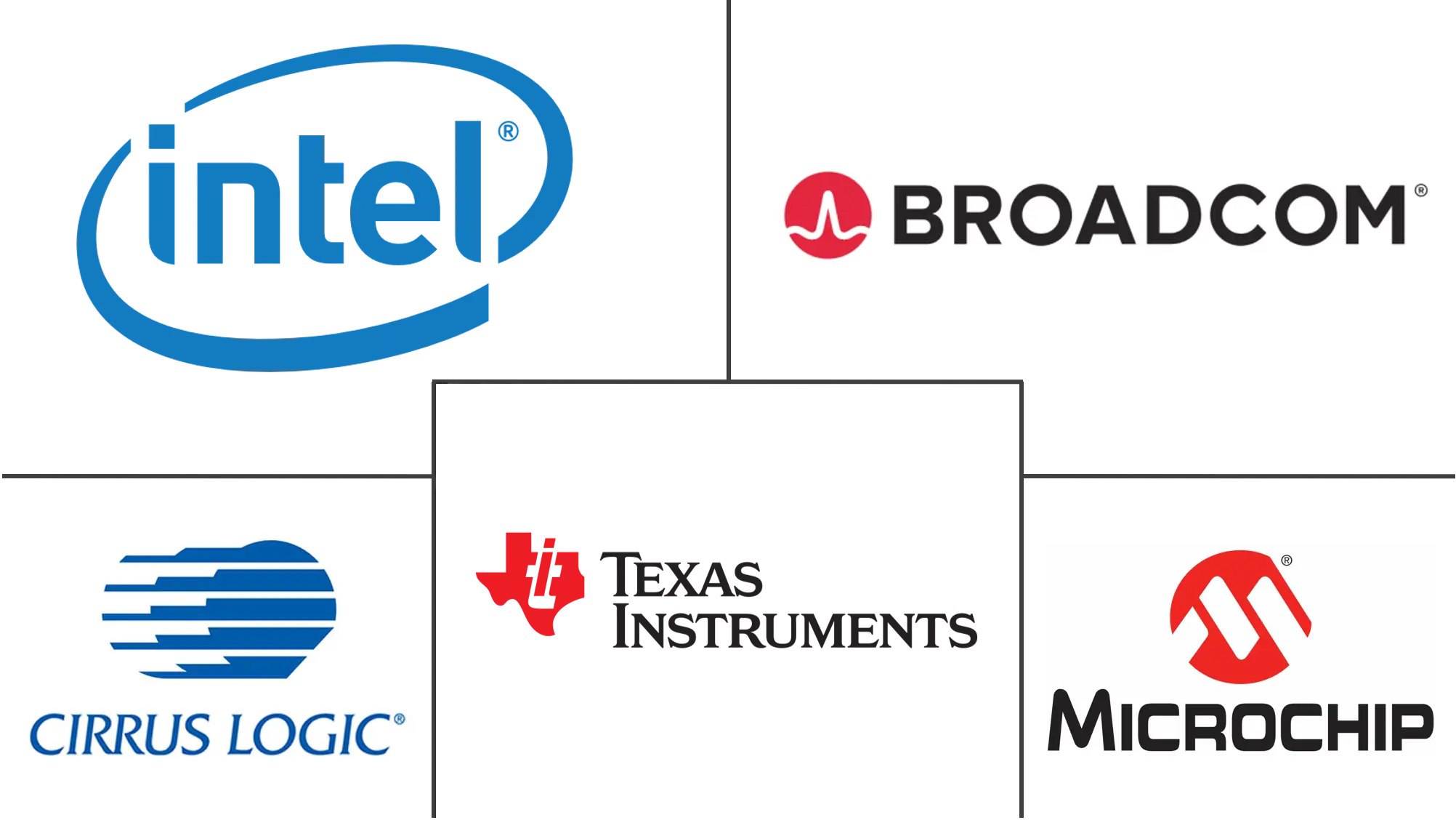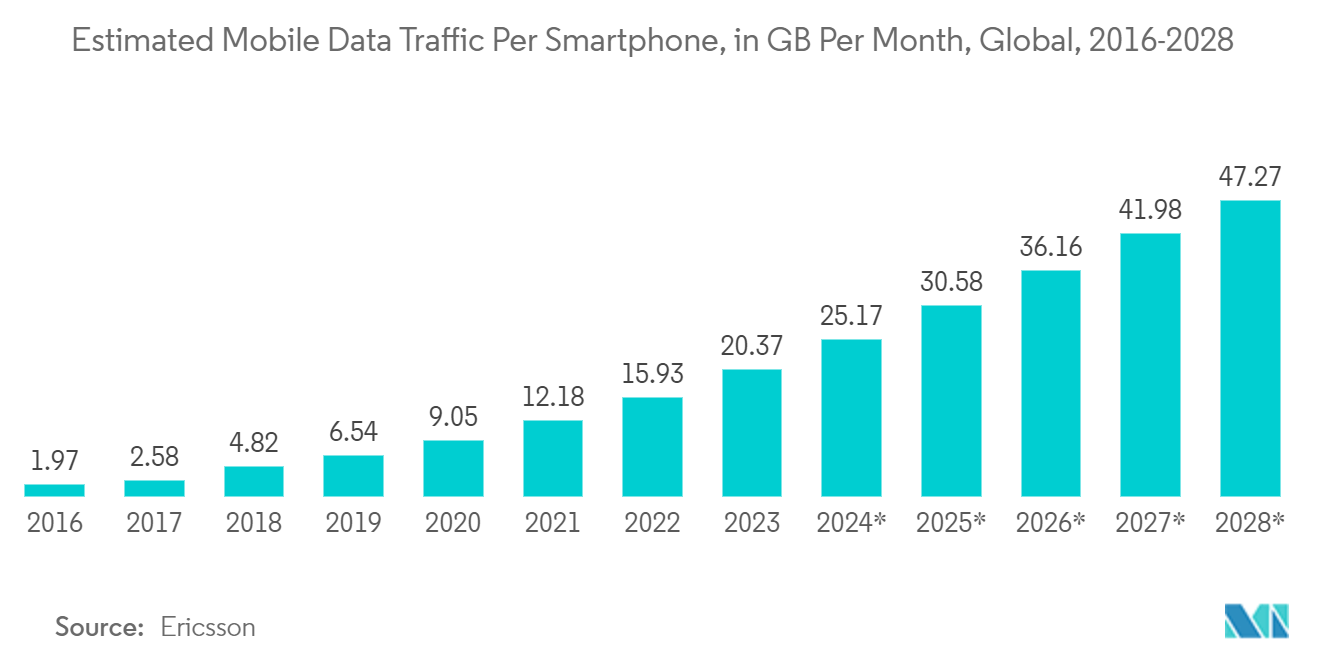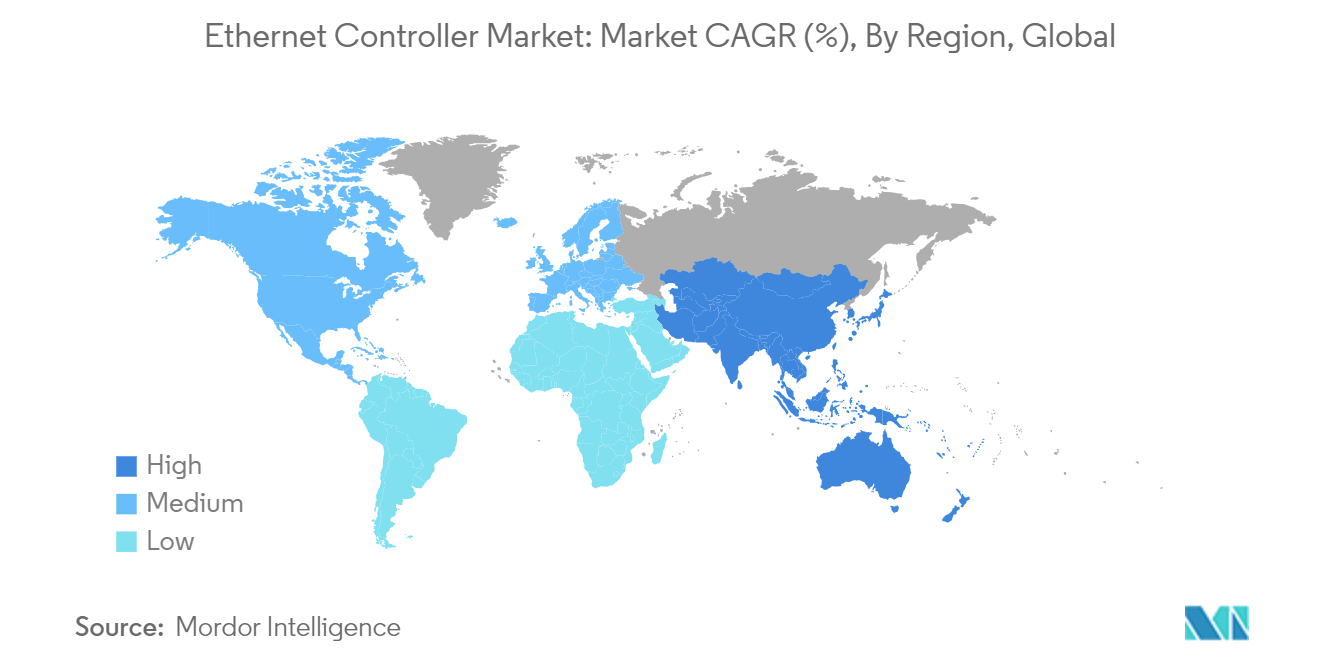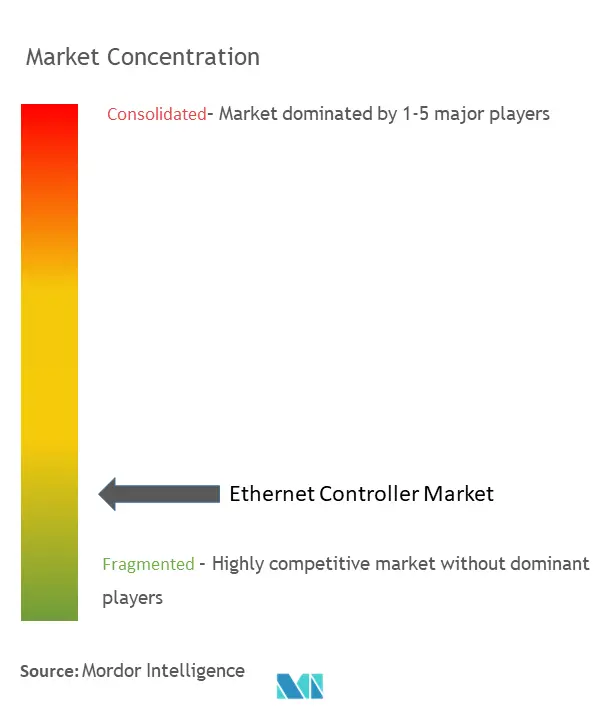Ethernet Controller Market Size

| Study Period | 2019 - 2029 |
| Market Size (2024) | USD 11.62 Billion |
| Market Size (2029) | USD 16.63 Billion |
| CAGR (2024 - 2029) | 7.42 % |
| Fastest Growing Market | Asia Pacific |
| Largest Market | North America |
Major Players
*Disclaimer: Major Players sorted in no particular order |
Ethernet Controller Market Analysis
The Ethernet Controller Market size is estimated at USD 11.62 billion in 2024, and is expected to reach USD 16.63 billion by 2029, growing at a CAGR of 7.42% during the forecast period (2024-2029).
The increasing adoption of data centers and cloud computing in the modern digital economy drives the market. From scientific discoveries to artificial intelligence (AI), modern data centers are crucial to solving some of the world's most important challenges. These modern data centers are transforming to increase networking bandwidth and optimize workloads, like AI.
The increasing data volume heightened the need for Ethernet controllers, thereby driving the market's growth. According to the Ericsson Mobility Report, the decline in data packet charges and increased smartphone usage accelerated data traffic across India. The report estimates that the volume of mobile data traffic is expected to reach over 21 exabytes per month by 2025.
Ethernet for Control Automation Technology (EtherCAT) is based on the CANopen protocol and Ethernet. However, it differs from Internet or network communications in that it is specifically optimized for industrial automation control. Utilizing the OSI network model, Ethernet and EtherCAT rely on the same physical and data link layers. Beyond that, the two networks diverge by design as they are optimized for different tasks.
A USB-to-ethernet converter is useful in various circumstances. For example, a user's laptop's Wi-Fi option may be experiencing technical difficulties, or the user may discover that the Wi-Fi is disabled for security reasons in specific locations despite users requiring internet access. An Ethernet port and a simple adapter should suffice in such circumstances, as a cable will provide a faster and more consistent connection.
The market is expected to create a roadblock for itself to update faster on technology, as such long-duration contracts with extensions saturate the market, thus impacting its growth. When the industry trends indicate that the solution and service providers should use new and emerging technology, such as Ethernet controllers, long-term contracts can be counterproductive in the market. Moreover, the growing competition in the market impacts the profit margins and growth of the existing vendors. The level of competition between suppliers is so high that Ethernet controller products are transitioning to be commoditized in the world.
The unanticipated swing in demand with reduced supply led to the ramping of production by several component manufacturers, which still fell short. The primary drivers behind the growth are the continued investments in digitizing global economies, the deployment of 5G technologies, and the robust investments in data centers and cloud services. The market is expected to witness growth in the coming years, owing to the increase in the demand for high-speed connectivity, driven by the ongoing 5G smartphone ramp-up and the continued strength of the cloud. According to Ericsson, 5G subscriptions are forecast to increase drastically from 2019 to 2028 globally, from over 12 million to over 4.5 billion subscriptions, respectively.
Ethernet Controller Market Trends
Servers to Hold the Largest Market Share
- Most businesses require data storage, whether for their email, website, or online transactions, and this may be done on a server. Servers are specialized computers linked to a company's local network and, in most cases, the Internet. If a company is small enough, it may keep its servers in-house and run them independently. However, as organizations and their demands expand, more servers and storage space are required as more data is generated. A typical data center infrastructure includes many servers, which are powerful computers.
- As servers power data centers and support cloud environments, the server industry is the backbone of innumerable mission-critical and client-side corporate computing operations. As businesses seek to power big data and advanced workload requirements, demand for higher-performing servers continues to climb. With the increasing cloud computation, AI, big data, and data centers, the need for servers will also grow significantly. With this growing demand for servers, Ethernet controllers will also increase.
- A baseboard management controller (BMC) monitors most modern servers' temperature, voltages, and fans. When something in the system requires an administrator's attention (such as the CPU overheating), the BMC may generally be set to send out notifications (in the form of emails and SNMP alerts).
- Application device queues (ADQ), dynamic device personalization (DDP), and support for both iWARP and RoCEv2 Remote Direct Memory Access (RDMA) are included in Intel Ethernet 800 Series controllers. It provides workload-optimized performance and the flexibility to meet changing network requirements. For high-performance server applications, including NFV, storage, HPC-AI, and hybrid cloud, the 800 Series controllers provide speeds up to 100GbE.
- Further, the NetXtreme-E Series BCM57414 50G PCIe 3.0 Ethernet controller is based on Broadcom's scalable 10/25/50/100/200G Ethernet controller architecture. This architecture is designed to build highly scalable, feature-rich networking solutions in servers for enterprise and cloud-scale networking and storage applications, such as high-performance computing, telco, machine learning, storage disaggregation, and data analytics.
- According to Ericsson, the data traffic is expected to triple by 2030. In 2023, smartphones across the globe used an average of 20.37 gigabytes of mobile data per month, up from 15.93 gigabytes the previous year. This figure is expected to reach 25.17 gigabytes in 2024 and 47.27 gigabytes by 2028. Thus, the distributed cloud that can secure the low latency and high bandwidth required to connect such scale easily is coming into action. Several technology giants are addressing the critical challenges while managing their servers and computational needs. A major factor responsible for the rising densities is the rapid rise of data-crunching for AI.

North America Holds Largest Market Share
- 5G requires a flexible networking and transportation infrastructure to reach its full potential. As Ethernet becomes the most efficient transport technology, carrier routers and switches are being charged with supporting a range of use cases over shared infrastructure, increasing Ethernet gear installations.
- According to Ericsson, 5G subscriptions are predicted to increase drastically in North America from 2019 to 2028, from over 1.07 million to over 405.4 million. With such massive growth in the 5G industry in the United States, the market will also see demand for Ethernet controllers.
- As an Ethernet controller allows wired connections to a computer network, any device requiring a high-speed internet connection has to use Ethernet controllers for fast internet connections. Such is the case with cloud infrastructure networks. With developing cloud capabilities and enterprises shifting their work to the cloud, the demand for cloud applications is increasing rapidly in the United States.
- Due to low costs, less maintenance, data security, and almost unlimited scalability, more businesses will opt for cloud storage solutions in the coming years. Therefore, this rise in cloud computing and storage will also surge in the ethernet controller market.
- The Communications Research Centre (CRC), Canada's leading advanced telecommunications research center, is dedicated to bringing 5G technology to Canadians to ensure they can use state-of-the-art telecommunications systems, technologies, and applications. According to GSMA, by 2030, 5G connections are predicted to account for 95% of all mobile connections in Canada.

Ethernet Controller Industry Overview
The ethernet controller market is highly fragmented due to the presence of both global players and small and medium-sized enterprises. Some of the major players in the market are Intel Corporation, Broadcom Inc., Microchip Technology Inc., Cirrus Logic Inc., and Texas Instruments Incorporated. Players in the market are adopting strategies such as partnerships and acquisitions to enhance their product offerings and gain sustainable competitive advantage.
In April 2024, Microchip acquired ADAS and Digital Cockpit Connectivity Pioneer VSI Co. Ltd to extend automotive networking. The market acquisition adds ASA Motion Link technology to Microchip’s broad Ethernet and PCIe automotive networking portfolio to enable next-generation software-defined vehicles.
In March 2024, Marvell Technology Inc., in partnership with TSMC, unveiled the industry's pioneering 2 nm semiconductor technology platform, tailored for high-speed infrastructure demands. The Marvell 2 nm platform, an extensive IP suite, addresses many infrastructure needs. It includes high-speed long-reach SerDes exceeding 200 Gbps, processor subsystems, encryption engines, system-on-chip fabrics, chip-to-chip interconnects, and high-bandwidth physical layer interfaces for computing, memory, networking, and storage. These advancements form the cornerstone for developing bespoke cloud-optimized compute accelerators, Ethernet switches, digital signal processors for optical and copper interconnects, and other devices crucial for fueling AI clusters, cloud data centers, and similar high-performance infrastructure.
Ethernet Controller Market Leaders
-
Intel Corporation
-
Broadcom Inc.
-
Microchip Technology Inc.
-
Cirrus Logic Inc.
-
Texas Instruments Incorporated
*Disclaimer: Major Players sorted in no particular order

Ethernet Controller Market News
- March 2024: NVIDIA unveiled the NVIDIA Blackwell platform, empowering organizations to develop and deploy real-time generative AI using trillion-parameter large language models. This new platform boasts a remarkable 25x reduction in cost and energy consumption compared to its predecessor. To further enhance AI capabilities, organizations can pair their systems powered by the GB200 with the newly introduced NVIDIA Quantum-X800 InfiniBand and Spectrum-X800 Ethernet platforms. These networking solutions offer advanced speeds of up to 800Gb/s.
- October 2023: Mouser Electronics Inc. offers Microchip Technology's LAN8650 and LAN8651 industrial-grade single-pair Ethernet switches. These switches connect microcontrollers without built-in Ethernet MAC to 10BASE-T1S SPE networks, enabling low-speed devices to integrate with standard Ethernet in automotive and industrial applications. The LAN865x series supports 8-, 16-, and 32-bit microcontrollers, streamlining communication systems.
Ethernet Controller Market Report - Table of Contents
1. INTRODUCTION
- 1.1 Study Assumptions and Market Definition
- 1.2 Scope of the Study
2. RESEARCH METHODOLOGY
3. EXECUTIVE SUMMARY
4. MARKET INSIGHTS
- 4.1 Market Overview
- 4.2 Industry Value Chain Analysis
-
4.3 Industry Attractiveness - Porter's Five Forces Analysis
- 4.3.1 Bargaining Power of Suppliers
- 4.3.2 Bargaining Power of Buyers
- 4.3.3 Threat of New Entrants
- 4.3.4 Threat of Substitute Products
- 4.3.5 Intensity of Competitive Rivalry
- 4.4 An Assessment of the Impact of Key Macroeconomic Trends
5. MARKET DYNAMICS
-
5.1 Market Drivers
- 5.1.1 Adoption of EtherCat for Realtime Network for Machine Control
- 5.1.2 Adoption of USB Ethernet Controllers
-
5.2 Market Restraints
- 5.2.1 Low Demand Due to Impact of COVID-19
- 5.2.2 Competitive Prices Led to Stiff Profit Margins
6. MARKET SEGMENTATION
-
6.1 By Bandwidth Type
- 6.1.1 Fast Ethernet
- 6.1.2 Gigabit Ethernet
- 6.1.3 Switch Ethernet
-
6.2 By Function
- 6.2.1 PHY (Physical Layer)
- 6.2.2 Integrated
-
6.3 By End Users
- 6.3.1 Servers
- 6.3.2 Routers and Switches
- 6.3.3 Consumer Applications
- 6.3.4 Other End Users
-
6.4 By Geography***
- 6.4.1 North America
- 6.4.1.1 United States
- 6.4.1.2 Canada
- 6.4.2 Europe
- 6.4.2.1 Germany
- 6.4.2.2 United Kingdom
- 6.4.2.3 France
- 6.4.3 Asia
- 6.4.3.1 India
- 6.4.3.2 China
- 6.4.3.3 Japan
- 6.4.4 Australia and New Zealand
- 6.4.5 Latin America
- 6.4.6 Middle East and Africa
7. COMPETITIVE LANDSCAPE
-
7.1 Company Profiles*
- 7.1.1 Intel Corporation
- 7.1.2 Broadcom Inc.
- 7.1.3 Microchip Technology Inc.
- 7.1.4 Cirrus Logic Inc.
- 7.1.5 Texas Instruments Incorporated
- 7.1.6 Silicon Laboratories Inc.
- 7.1.7 Marvell Technology Group
- 7.1.8 Realtek Semiconductor Corp.
- 7.1.9 Cadence Design Systems Inc.
- 7.1.10 Futurlec Inc.
8. INVESTMENT ANALYSIS
9. MARKET OPPORTUNITIES AND FUTURE TRENDS
** Subject To AvailablityEthernet Controller Industry Segmentation
An Ethernet controller is a small chip that handles all the data swapped between two computers or servers through the Internet. This industry's growth is expected to be positive during the forecast period due to increased data traffic, with work cultures leaning toward remote work and BYOD devices.
The ethernet controller market is segmented by bandwidth type (fast ethernet, gigabit ethernet, and switch ethernet), function (PHY, integrated), end users (servers, routers and switches, consumer applications, and other end users), and geography (North America [United States and Canada], Europe [Germany, United Kingdom, France, and Rest of Europe], Asia-Pacific [India, China, and Japan], Latin America, and Middle East and Africa). The market sizes and predictions are provided in terms of value in USD for all the above segments.
| By Bandwidth Type | Fast Ethernet | |
| Gigabit Ethernet | ||
| Switch Ethernet | ||
| By Function | PHY (Physical Layer) | |
| Integrated | ||
| By End Users | Servers | |
| Routers and Switches | ||
| Consumer Applications | ||
| Other End Users | ||
| By Geography*** | North America | United States |
| Canada | ||
| By Geography*** | Europe | Germany |
| United Kingdom | ||
| France | ||
| By Geography*** | Asia | India |
| China | ||
| Japan | ||
| By Geography*** | Australia and New Zealand | |
| Latin America | ||
| Middle East and Africa |
Ethernet Controller Market Research FAQs
How big is the Ethernet Controller Market?
The Ethernet Controller Market size is expected to reach USD 11.62 billion in 2024 and grow at a CAGR of 7.42% to reach USD 16.63 billion by 2029.
What is the current Ethernet Controller Market size?
In 2024, the Ethernet Controller Market size is expected to reach USD 11.62 billion.
Who are the key players in Ethernet Controller Market?
Intel Corporation, Broadcom Inc., Microchip Technology Inc., Cirrus Logic Inc. and Texas Instruments Incorporated are the major companies operating in the Ethernet Controller Market.
Which is the fastest growing region in Ethernet Controller Market?
Asia Pacific is estimated to grow at the highest CAGR over the forecast period (2024-2029).
Which region has the biggest share in Ethernet Controller Market?
In 2024, the North America accounts for the largest market share in Ethernet Controller Market.
What years does this Ethernet Controller Market cover, and what was the market size in 2023?
In 2023, the Ethernet Controller Market size was estimated at USD 10.76 billion. The report covers the Ethernet Controller Market historical market size for years: 2019, 2020, 2021, 2022 and 2023. The report also forecasts the Ethernet Controller Market size for years: 2024, 2025, 2026, 2027, 2028 and 2029.
Ethernet Controller Industry Report
Statistics for the 2024 Ethernet Controller market share, size and revenue growth rate, created by Mordor Intelligence™ Industry Reports. Ethernet Controller analysis includes a market forecast outlook to 2029 and historical overview. Get a sample of this industry analysis as a free report PDF download.



